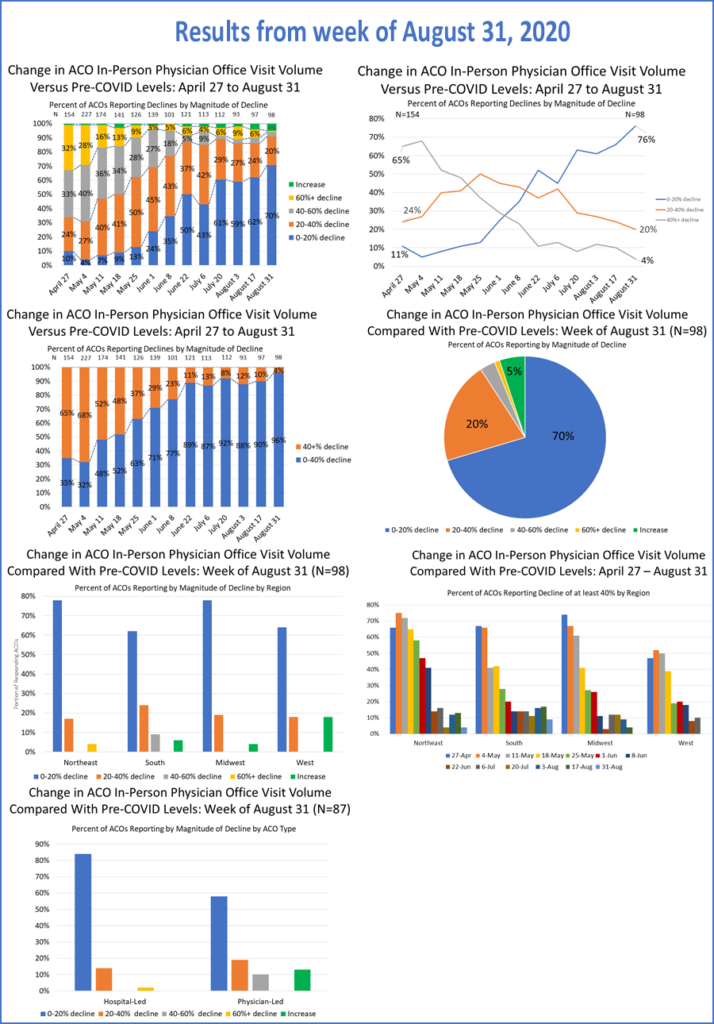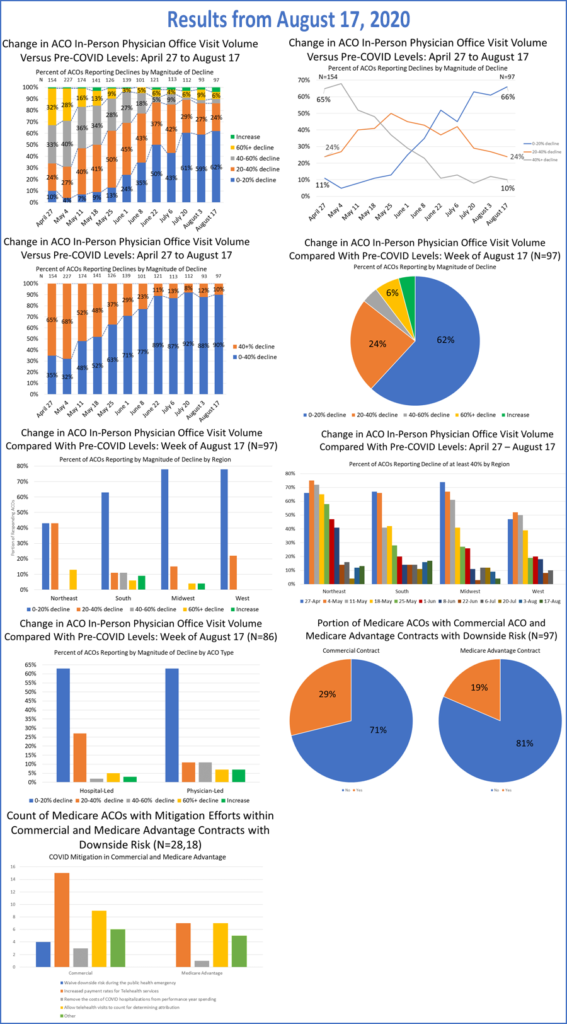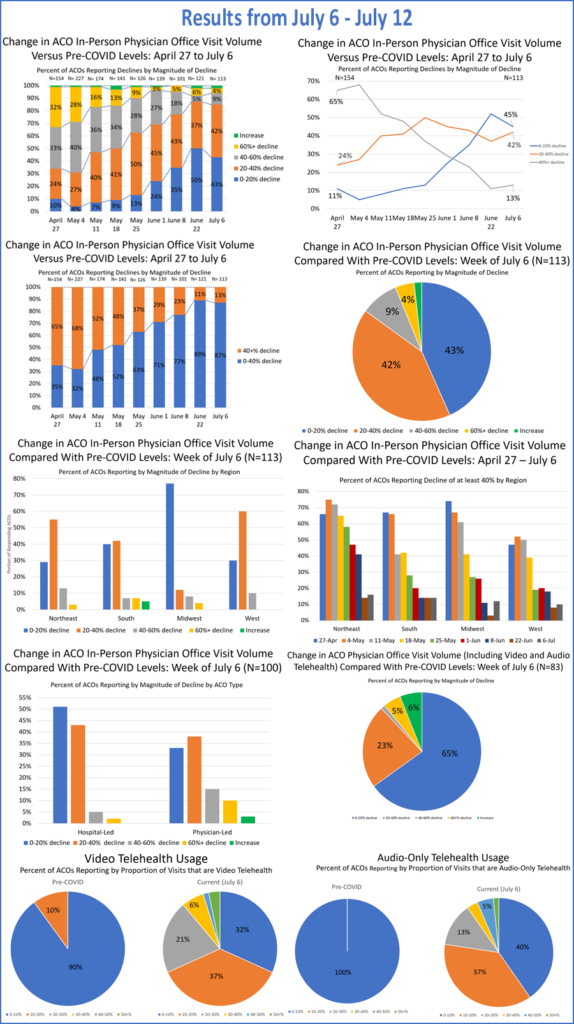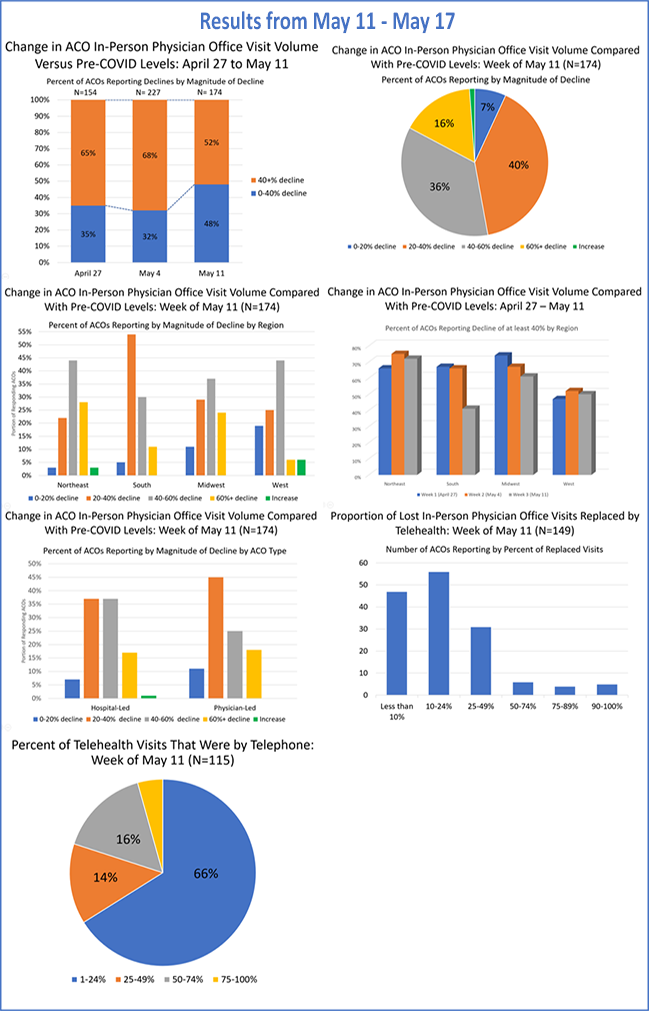Results from Weekly Poll About COVID’s Impact on In-Person Visits
During the week of September 14th, 104 ACOs reported on changes in their in-person office visit volume compared with pre-COVID volume levels. This week’s report shows relatively steady visit volume compared to two weeks ago. The proportion of respondents with in-person visits down by 20 percent or rose slightly, going from 70 percent two weeks ago to 73 percent this week. However, the proportion of ACOs presenting declines of more than 40 percent also rose slightly, going from 4 percent two weeks ago to 6 percent this week. The most notable occurrence in the regional data this week is that the West had an ACO report visit volumes with a greater than 40 percent decline for the first time in two months. The South still leads all regions in this category, with 14 percent of their ACOs reporting decreases of such magnitude. Physician-led ACOs again have a higher portion of respondents reporting declines of 40+ percent than do hospital-led ACOs. On the other hand, the only ACO reporting greater than expected visit volume is a physician-led ACO.
Click the image for a larger view.

During the week of August 31st, 98 ACOs reported on changes in their in-person office visit volume compared with pre-COVID volume levels. This week’s report shows an increase in visit volume compared to two weeks ago. The proportion of respondents with in-person visits down by 20 percent or less rose noticeably, going from 62 percent two weeks ago to 70 percent this week. This week also marks the first time that more ACOs saw greater than expected visit volume (5 percent) than saw a decline of more than 40 percent over expected pre-COVID levels (4 percent). The most notable occurrence in the regional data this week is that the Midwest has joined the West in having no ACOs report visit volumes with a greater than 40 percent decline. The south still leads all regions in this category, although they still have less than 10 percent of their ACOs reporting decreases of such magnitude. Physician-led ACOs again have a higher portion of respondents reporting declines of 40+ percent than do hospital-led ACOs. On the other hand, every ACO reporting greater than expected visit volume is a physician-led ACO.
Click the image for a larger view.

During the week of August 17th, 97 ACOs reported on changes in their in-person office visit volume compared with pre-COVID volume levels. This week’s report once again shows very little change in visit volume compared to two weeks ago. The proportion of respondents with in-person visits down by 20 percent or less rose slightly, going from 59 percent two weeks ago to 62 percent this week. Overall, the change from two weeks ago is once again minimal, with no category showing a change of more than 3% from the previous survey. The South has remained the region with the most significant declines in visits this week with 17 percent of respondents reporting a decline of 40+ percent over pre-COVID levels. Declines in visit volume reported by physician-led ACOs remain slightly larger than declines reported by hospital-led ACOs.
This week, we added multiple questions surrounding private payer contracts with downside risk. Of the 97 respondents, 29% also have a commercial ACO contract with downside risk and 19% also have a Medicare Advantage contract with downside risk. We also asked about steps these private payer contracts have taken to mitigate risk given the uncertainty surrounding the COVID-19 pandemic. For commercial ACOs, the most common step by far was increasing the payment rates for telehealth visits, with more than half of ACOs with commercial contracts stating that such a step had been taken. Increased payment for telehealth is also tied with allowing telehealth visits to count for determining attribution as the most popular option for Medicare Advantage (MA) contracts, however both were present in less than 40 percent of MA contracts.
Click the image for a larger view.

During the week of August 3rd, 93 ACOs reported on changes in their in-person office visit volume compared with pre-COVID volume levels. This week’s report shows very little change in visit volume compared to two weeks ago. The proportion of respondents with in-person visits down by 20 percent or less stayed nearly static, going from 61 percent two weeks ago to 59 percent this week. Indeed, the most significant change by category was in the proportion of ACOs with visit volume down by 60+ percent, which went from 6 percent last week to 9 percent this week. The South has taken over as the region with the most significant declines in visits this week with 16 percent of respondents reporting a decline of 40+ percent over pre-COVID levels. Declines in visit volume reported by physician-led ACOs remain slightly larger than declines reported by hospital-led ACOs.
Click the image for a larger view.

During the week of July 20th, 112 ACOs reported on changes in their in-person office visit volume compared with pre-COVID volume levels. This week’s report once again shows an increase in visit volume over two weeks ago. This comes after the previous survey reported the first decrease in visit volume in nearly two months. In particular, the proportion of respondents with in-person visits down by 20 percent or less rose considerably, from 43 percent two weeks ago to 61 percent this week. The Northeast is no longer reporting the largest declines, with the Midwest now taking over that title. However, even the Midwest has just 12 percent of respondents reporting a decline of 40+% over pre-COVID levels. Declines in visit volume reported by physician-led ACOs remain somewhat larger than declines reported by hospital-led ACOs.
Click the image for a larger view.

During the week of July 6th, 113 ACOs reported on changes in their in-person office visit volume compared with pre-COVID volume levels. This week’s report shows a slight decrease in visit volume for the first time since the beginning of May. In particular, the proportion of respondents with in-person visits down by 20 percent or less dropped for the first time in two months, from 50 percent two weeks ago to 43 percent this week. The Northeast is still reporting the largest declines, however, the proportion of ACOs reporting in-person visit declines of 40+ percent is between 10 and 16 percent in every region surveyed. Declines reported by physician-led ACOs remain notably larger than declines reported by hospital-led ACOs.
This week, we also added multiple questions surrounding telehealth usage. When accounting for video and audio telehealth, the proportion of ACOs reporting declines in visit volume of 20 percent or less rose to 65 percent. Another 6 percent of respondents said that, including telehealth, their visit volume is greater than expected pre-COVID. Additionally, 100 percent of responding ACOs reported that, prior to COVID, audio-only telehealth made up 10 percent or less of their office visits. 90 percent of ACOs reported the same about video-based telehealth. However, just 40 and 32 percent, respectively, of responding ACOs state that current telehealth usage remains within that range. And, while no responding ACOs reported audio-only or visual telehealth making up more than 20 percent of their office visits pre-COVID, 23 and 32 percent of reporting ACOs now have audio-only and video visits, respectively, make up more than 20 percent of their office visits.
Click the image for a larger view.

During the week of June 22nd, 121 ACOs reported on changes in their in-person office visit volume compared with pre-COVID volume levels. This week’s report shows continued improvement in visit volume. In particular, the proportion of respondents with in-person visits down by 20 percent or less rose again from 35 percent two weeks ago to 50 percent this week. The Northeast is no longer reporting the largest declines, as they have now caught up with the South in terms of ACOs reporting in-person visit declines of 40+%. Declines reported by physician-led ACOs were notably larger than declines reported by hospital-led ACOs.
Click the image for a larger view.

During the week of June 8th, 101 ACOs reported on changes in their in-person office visit volume compared with pre-COVID volume levels. This week’s report shows continued improvement in visit volume. In particular, the proportion of respondents with in-person visits down by 20 percent or less rose again from 24 percent last week to 35 percent this week. The declines remained highest in the Northeast, although they continue to move towards pre-COVID levels across all regions. Declines reported by hospital-led and physician-led ACOs remain relatively similar.
Click the image for a larger view.

During the week of June 1st, 139 ACOs reported on changes in their in-person office visit volume compared with pre-COVID volume levels. This week’s report shows continued improvement in visit volume. In particular, the proportion of respondents with in-person visits down by more than 60 percent fell again from 9 percent last week to 3 percent this week, while the portion of ACOs seeing declines of 0-20 percent grew from 13 percent last week to 24 percent this week. The declines remained highest in the Northeast, although for the first time more than half of the ACOs in that region saw in-person visit declines of 40 percent or less. Declines reported by hospital-led and physician-led ACOs were virtually identical.
This week, we also asked several ACOs with two-sided risk models if they submitted a termination notice to the Medicare Shared Savings Program by the June 1 deadline. Of 28 respondents, none had. 79% stated they plan to stay in for the full year, with just 18% saying they intend to evaluate leaving sometime later this year.
Click the image for a larger view.

During the week of May 25th, 126 ACOs reported on changes in their in-person office visit volume compared with pre-COVID volume levels. This week’s report shows some improvement in visit volume. In particular, the proportion of respondents with in-person visits down by more than 60 percent continued to fall from 13 percent last week to 9 percent this week, while 50 percent of respondents stated they were currently seeing a 20-40% reduction in visit volume. The declines remained highest in the Northeast, while visit levels in the South, Midwest, and West continue to recover swiftly. Declines reported by hospital-led and physician-led ACOs were similar, although they were slightly larger amongst physician-led ACOs.
Click the image for a larger view.

During the week of May 18th, 141 ACOs reported on changes in their in-person office visit volume compared with pre-COVID volume levels. This week’s report shows some improvement in visit volume. In particular, the proportion of respondents with in-person visits down by more than 60 percent continued to fall from 16 percent last week to 13 percent this week. The declines remained highest in the Northeast, although the Midwest, which had previously had declines nearly as significant as the Northeast, is now much more in line with the South. Declines reported by hospital-led and physician-led ACOs were similar, although they were slightly larger amongst physician-led ACOs.
This week, NAACOS asked ACOs about steps ACOs have taken to support patients and providers during the COVID-19 pandemic. The most popular step was to deploy telehealth technology and education for MD visits, with 90% of those surveyed stating that a major effort was underway. Other popular actions include the implementation of check-in calls with clinically vulnerable patients, check-in calls for patients with complex social needs, and virtual care for COVID-19 patients after discharge.
Click the image for a larger view.

During the week of May 11th, 174 ACOs reported on changes in their in-person office visit volume compared with pre-COVID volume levels. This week’s report shows some improvement in visit volume. In particular, the proportion of respondents with in-person visits down by more than 60 percent dropped from 28 percent last week to 16 percent this week. The declines remained highest in the Northeast followed by the Midwest. Declines reported by hospital-led ACOs were somewhat greater than those for physician-led ACOs.
This week, NAACOS asked ACOs about the proportion of lost in-person visits that had been replaced with telehealth visits. Only 10 percent of respondents reported that they had made up for at least half of their lost visits with telehealth. Seventy percent of respondents reported that they were able to make up fewer than 25 percent of lost in-person visits with telehealth. Most respondents reported that a majority of new telehealth visits included video and a minority were telephone only. Details are provided in the following charts.

During the week of May 4, 227 ACOs reported on changes in their in-person office visit volume compared with pre-COVID volume levels. About 25 percent of respondents reported a decline of 60 percent or more in in-person office visit volume. Forty percent of respondents reported declines between 40 and 60 percent. Patterns of reported declines in visits were roughly comparable to ACO reports from last week. Declines in in-person visit volume remained highest in the Northeast and lowest in the West. Declines reported by physician-led and hospital-led ACOs were nearly identical. Overall, there was relatively little change compared with the prior week.

During the week of April 27th, 154 ACOs reported on changes in their in-person office visit volume compared with pre-COVID volume levels. Nearly one-third of respondents reported a decline of 60 percent or more in office visit volume. Another one-third of respondents reported declines between 40 and 60 percent. The declines were most notable in the Northeast and the Midwest, where close to half of ACOs reported a decrease of 60 percent or more. The lowest reported declines were reported by ACOs in the West. Finally, there was also a discrepancy based on ACO type. A larger share of physician-led ACOs reported drops in visits of at least 40 percent compared with hospital-led ACOs (70 percent versus 60 percent). Details are provided in the following charts.

